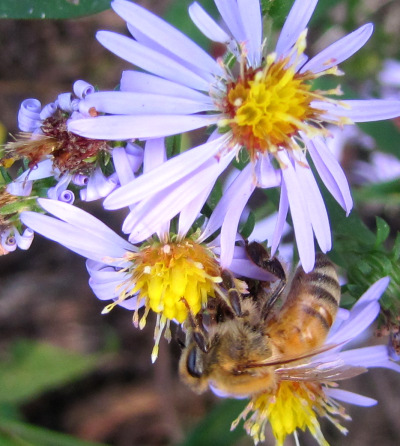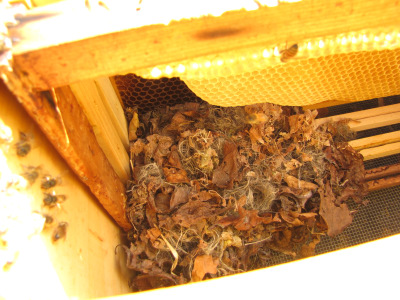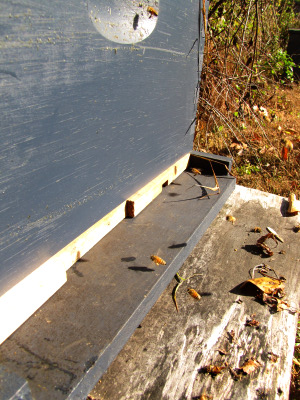
Mouse guard
 Last
year, I watched dozens of bees visit the New England Aster my mom had
planted in her city front yard, and before I left, I'd begged some
seeds from her bee-beloved plants. I scattered the seeds in the
forest garden, then ignored them as they came up through weeds this
spring.
Last
year, I watched dozens of bees visit the New England Aster my mom had
planted in her city front yard, and before I left, I'd begged some
seeds from her bee-beloved plants. I scattered the seeds in the
forest garden, then ignored them as they came up through weeds this
spring.
When four plants made it
to the blooming stage, I watched with baited breath, expecting a three
ring circus. But our bees rolled their eyes at me and went back
to feeding on the wild asters growing here, there, and everywhere
around our homestead. My guess is that honeybees like asters in general, and that the New England
Aster was such a big hit in my mother's yard just because so few people
in the city grow asters of any sort.

Despite frosts, our bees
are still hard at work gathering nectar and pollen from our asters, so
I had planned to leave off their mouse guards until activity began to
slow. But when I checked
on the colonies this week, I found a mouse nest in the back corner of
one of the
hives. The mouse wasn't present, but it had clearly spent a lot
of time ferrying in leaves and dried grass to make its home.
I raked out all of the
 leaves and even shook the bottom board off to
clean it. (The bees didn't seem to mind my housekeeping all that
much.) Then I put the hive back together and installed an
entrance reducer to keep out further squatters. The bees will
just have to work those asters through the small hole from now on.
leaves and even shook the bottom board off to
clean it. (The bees didn't seem to mind my housekeeping all that
much.) Then I put the hive back together and installed an
entrance reducer to keep out further squatters. The bees will
just have to work those asters through the small hole from now on.
Want more in-depth information? Browse through our books.
Or explore more posts by date or by subject.
About us: Anna Hess and Mark Hamilton spent over a decade living self-sufficiently in the mountains of Virginia before moving north to start over from scratch in the foothills of Ohio. They've experimented with permaculture, no-till gardening, trailersteading, home-based microbusinesses and much more, writing about their adventures in both blogs and books.
Want to be notified when new comments are posted on this page? Click on the RSS button after you add a comment to subscribe to the comment feed, or simply check the box beside "email replies to me" while writing your comment.
- Remove comment
- Remove comment
